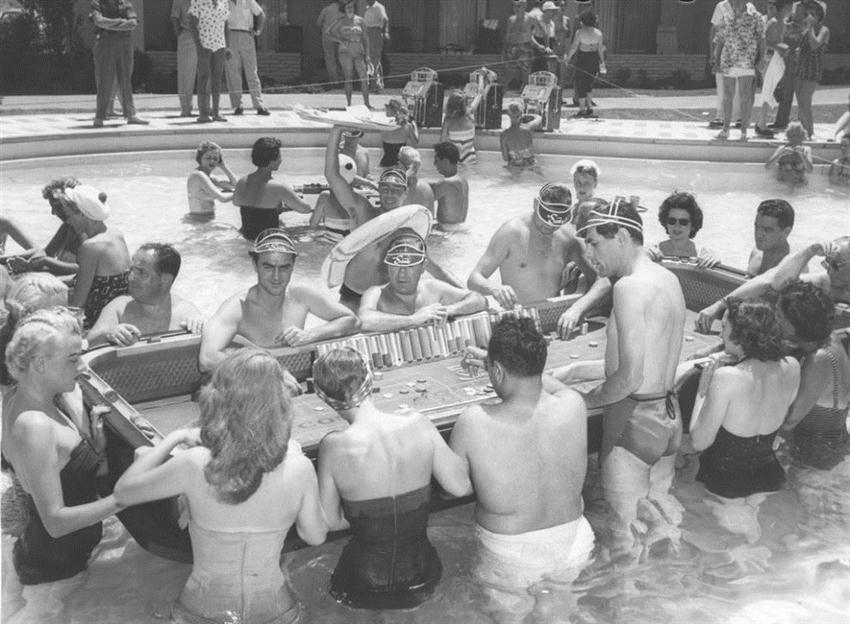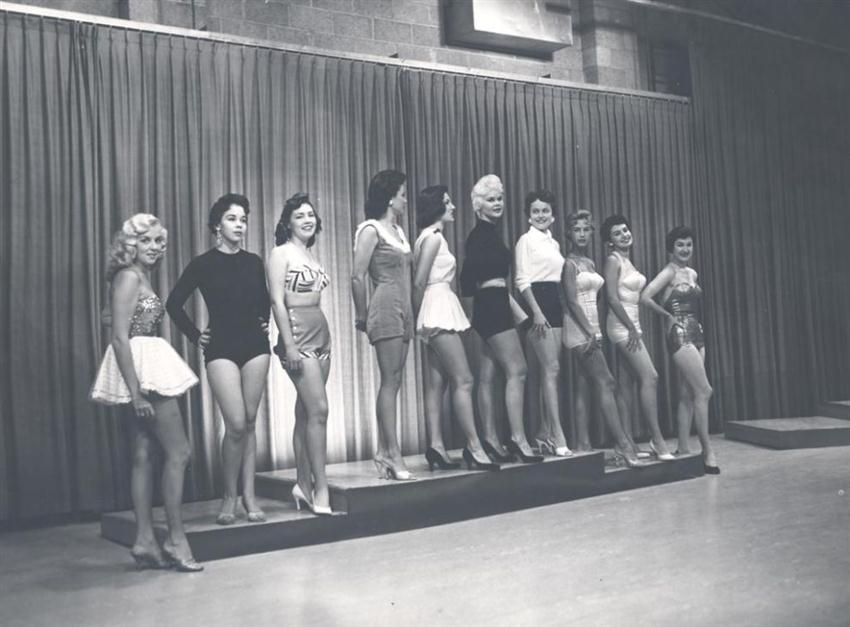Las Vegas is now
synonymous with gambling, casino, entertainment and tourism. But in the
first years of its existence, it was just a major railway junction in the
middle of the Mojave Desert, Nevada. Conventionally, the
history of the casinos in Vegas can be divided into four epochs: 1905-1945 -
the struggle for recognition, 1946-1960 - getting national fame, 1961-1988 -
the golden age of the casino, 1989-2012 - on the world stage.
Las Vegas
appeared in the central part of the Mojave Desert after the land auction, which
took place on 15 and 16 May 1905. At the time, no one could have predicted
the rapid development of the city in the next 100 years.
When the
railroad planned to Vegas, they gave a special quarter where you can enjoy a
variety of evil things: drink, rent prostitutes, gambling.
Club
"Arizona" was the most popular destination for those who came in the
16th quarter for fun.
At first it
was the usual shabby little house, and later became the club monumental
building with a tape measure and faro games.
"Arizona
Club" was one of the first in the Las Vegas gaming clubs actively promote
themselves.
1908. The
Legend of the Wild West Wyatt Earp poses with club owner Al James. In
1919, gambling was outlawed, but in the 16th quarter of the game went
underground.
May 19, 1931
in the state of Nevada gambling was re-enabled. All will fit the bill just
6 pages. Today, the game industry is regulated by the tens of thousands of
pages of local and federal regulations.
Also in 1931,
just 40 miles from the Las Vegas began construction of the Hoover Dam, which
ended in 1936. The emergence of the lake (reservoir) Mead and
commissioning of the power plant provided an opportunity for the effective
development of the City in the surrounding rocky desert. Questions water
and energy for many years were dropped.
Clubs in
downtown on Fremont Street quickly became legal gambling halls. Northern
Club, owned by Mamie Stoker, was the first licensed gaming establishments
Nevada, which had zhenschinea
Boulder
Club offering blackjack, craps, roulette, Pharaoh, bingo and taking bets on a
variety of competitions.
Bingo has
always been popular in Vegas, in the 1930s the game was often called
tango. "Keno" then it was more like bingo than today's analog.
Hotel Sal
Sagev on Fremont Street, originally called the Hotel Nevada, began operation
in 1906. Later it was expanded to additional rooms and a casino. Now
called Golden Gate and is the oldest continuously operating hotel in the
city.
Hotel El
Cortez, opened in 1942, was one of the major holiday destinations in those
days. It was significantly expanded (originally there were 90 rooms), but
in spite of this building now looks like in the 42nd.
The
world-famous neon signs. Club Eldorado was later bought by the legendary
Benny Binion and renamed Horseshoe. "Horseshoe" is now one of
the most famous names in the gaming industry.
Casino Golden Nugget was opened in 1946 by the former chief of the Los Angeles
Police Guy McAfee. It was a tiny game room, and later turned into a luxury
hotel and casino.
Historically,
the casinos in Las Vegas were only allowed in the city center on Fremont
Street. Due to the rapid development of the industry after the Second
World places you in starting your own business there was not. This has
forced some businesses to open their establishments beyond the administrative
boundary of the city. So there was the famed Las Vegas Strip - about
semikilometrovy site Las Vegas, which is now the majority of the largest hotels
and casinos of Las Vegas metropolitan area.
The
hotel-casino El Rancho Vegas became the first object of the Las Vegas
Strip. In contrast to the gaming rooms in the center of the city
"Rancho" offers a wider range of services. So began to emerge
casino-resorts. Currently, the Strip is the set of institutions that
combine hotel, shopping mall, park, etc.
Also
widespread themed casino. The Last Frontier was a pioneer in this
field. Wild West theme has been very popular and widely
used. Visitors' Frontira "picked up from the airport on this horse-drawn
carriage.
The
Flamingo - one of the most legendary casino resorts in Las Vegas
Strip. It was opened in late 1946. Billy Wilkerson was the same
visionary who started the construction of this luxurious multi-functional
object.
The hotel-casino The Desert Inn, open April 24, 1950, was actually a self-contained
resort. There was a golf course with 18 holes, luxurious
accommodation. After a relaxing day by the pool followed night games at
high rates. The place has become the undisputed leader of the Las Vegas
Strip.
On the
opening day The Desert Inn was packed to capacity.
Leaflet Fabulous Las Vegas Jack Cortez was the first magazine dedicated to the
nightlife of Vegas. There are advertised all the "miracles" of
the city, which had the potential to attract visitors.
This photo
was taken in the autumn of 1954. Las Vegas Strip, then was still not very
impressive. One and two-story buildings even today do not convey the
splendor of the boulevard. By the way, neon signs had already been used
quite often.
And do not
tell me that they have recently, for example, splashing in the pool or playing
golf.
Casino Moulin Rouge was one of the first, which has moved away from racial
segregation and opened its doors completely to all visitors. At first it
was very successful, but later closed down due to financial problems. In
1961, the rest of the place of the Las Vegas Strip followed the "MR"
and began to let everyone regardless of skin color.
In April
1955 opened with great fanfare hotel-casino Riviera. At the time of
discovery, he was the ninth entertainment complex on the Strip and the first
high-rise (9 floors). Riviera - the only large entertainment complex on
the Las Vegas Strip, which has no theme. All the other hotels, casinos
have chosen to lure tourists any specific subject.
After the
"Riviera" many other casinos started planning high-rise
buildings. On the slide depicts the famous tower of the hotel-casino Sands. Martin Stern has designed her junior.
PR-directors
are constantly trying to come up with some innovative "chips." E
Freeman - PR-director of Sands - offered to put tables for blackjack, craps
and roulette straight to the pool.
In the
evenings, many casinos are all kinds of celebrations. In the photo the
so-called Copa Room in Sands, is allotted for these purposes.
Like many
other casinos in Sands had its own dance troupe. Copa Girls were held
in most of the hotel shows.
In 1958 he
opened a resort-casino Stardust 800 rooms. At that time it was the
largest resort in the Strip. Neon sign was visible from a distance that is
constantly aroused the curiosity of potential customers. One time
institution began to pursue financial problems. Owners discharged from
Paris burlesque and cabaret show The Lido, which helped to keep the visitors.
The first
half-naked Vegas show Lido de Paris marked the beginning of a pen and Strass
extravaganza.
Entertainment
establishments in population density contributed to the weekend. To fill
the hotels during the week, at the end of the 50th there were held the various
conventions. In the photo session at the National Automobile Dealers Sands.
Vegas is
also famous for its weddings. At the end of the 50th casinos started
offering customers special wedding ceremony. And the celebrities did not
hesitate to use them. In the photo the famous American entertainer, singer
and actor Sammy Davis Jr. and his wife Lore. This wedding has helped to
stimulate interest in the service from others.
Meanwhile,
the places on the Fremont Street tried to keep up with the development of the
Las Vegas Strip. In 1956, it opened a 15-storied hotel «Fremont».
In 1964, the
casino-hotel Mint built next door to a high-rise.
Hotels Mint and Fremont.
Postcard-Guide
to Vegas late 50's.






































No comments:
Post a Comment